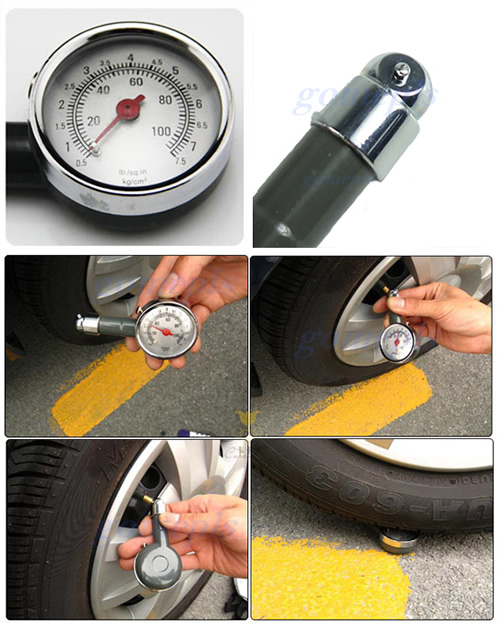Maintaining proper tire inflation is relatively simple and essential to the overall tire performance of your vehicle. A properly inflated tire will provide longer life, quicker steering response, better fuel efficiency and a smoother ride than an improperly inflated tire. Both underinflation and overinflation can cause headaches like premature treadwear and possible tire failure. The best way to ensure you're getting the most out of your tires is to check your tire pressure on a monthly basis.
Knowing how to use a tire pressure gauge is very simple. Here’s how to check tire pressure and refill your tires.
Items You Need When Checking Tire Pressure
Tire pressure gauge
Air compressor
Pen and paper
Your tire pressure gauge can be digital or standard. Auto parts stores typically carry both. Many auto parts stores sell portable air compressors that run from your car battery or 12v power port. Alternatively, you can use the air compressor found at most gas stations. They usually cost $0.50 or $1.00 to use.
Vehicle manufacturers specify PSI – literally “pounds per square inch” of pressure – assuming tires are cold. Tires are considered cold when the vehicle has been parked for three hours or more, or if the vehicle has been driven less than a mile (1.6 km) at moderate speed. PSI is the unit your pressure gauge uses to provide readings.
Look on the driver’s side door jamb or your owner’s manual to find the recommended cold tire PSI for your front and rear tires. If you cannot find it, you should consult your vehicle dealer, manufacturer, or a qualified tire professional.
If your front and rear tires require different pressure levels, write down the correct PSI for each to avoid getting confused as you move around your vehicle checking tire pressure.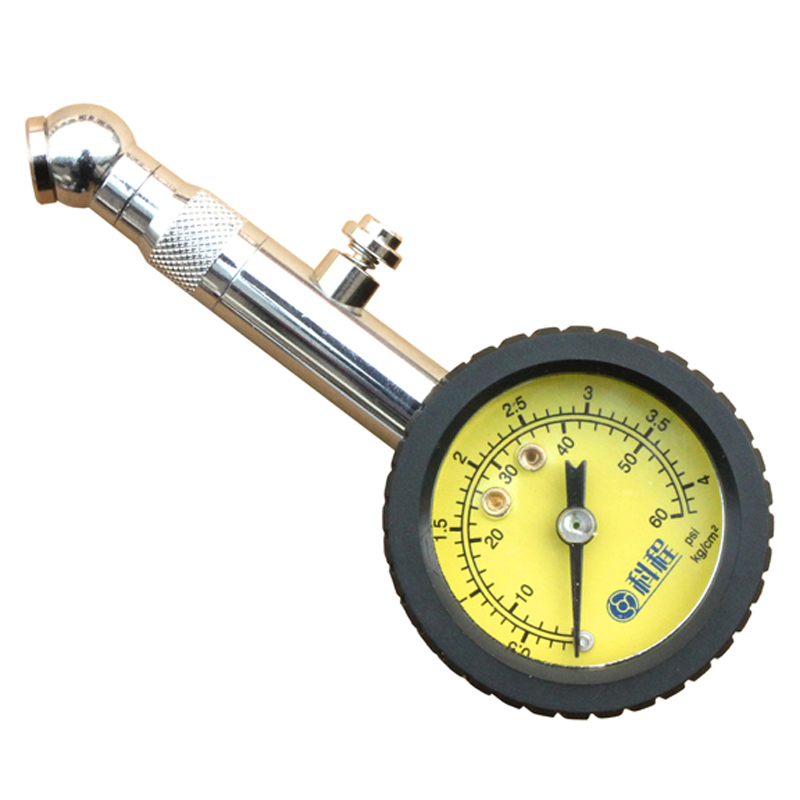
Remove the valve cap from one of your tires. Then place the pressure gauge on the valve stem and press down hard enough so the hiss sound disappears and your gauge provides a reading. With a standard gauge, the air pressure will push a small bar out from the bottom of the gauge. Measurement units are etched into the bar. A digital gauge will show you the reading on a screen.
Write down the reading and repeat this process for all four tires.
Use an air compressor to refill any tires with low pressure. Many air compressors are different, so read directions carefully to be sure you’re using it correctly.
If you’re using the air compressor at a gas station, be sure to park so that the hose will reach all four tires. Insert change into the machine until you hear the motor running. Fill each tire by placing the end of the hose over the valve stem and pressing on the lever.
Using a gas station air compressor means your tires might be “hot. ” If it is necessary to adjust inflation pressure when tires are “hot”, set their pressure to 4 psi (14 kPa) above the recommended cold inflation pressure. Recheck the inflation pressure when the tires are cold.
” If it is necessary to adjust inflation pressure when tires are “hot”, set their pressure to 4 psi (14 kPa) above the recommended cold inflation pressure. Recheck the inflation pressure when the tires are cold.
After filling your tires, use the gauge to check pressure again. At this point, it’s ok if you overfilled the tires because you can always let some air back out. Never drive on overinflated tires. Overinflation can result in decreased traction, premature wear, and decreased impact absorption.
Make the above procedure a monthly ritual. Regularly checking your tire pressure is the best way to ensure your tires never dip far below the optimal PSI.
Accuracy matters and you should keep that in mind when choosing a gauge. For just a few dollars, you can find a quality, accurate tire pressure gauge that gives accurate readings. If you’re not sure which one to purchase, ask a professional technician which he or she prefers.
A digital tire pressure gauge will provide accurate readings, but don’t forget that it operates on a battery. If you think having to replace the battery will prevent you from using it, it’s best to go with a standard gauge.
It’s best to use your personal tire gauge versus those available attached to air hoses at service stations. Of all the pressure gauges out there, they’re the most likely to be weathered, and possibly inaccurate.
There’s never a good time for a flat. That’s why Bridgestone DriveGuard tires are masterfully engineered to keep you moving for up to 50 miles at speeds up to 50 MPH without disruption.
There’s never a good time for a flat. That’s why Bridgestone DriveGuard tires are masterfully engineered to keep you moving for up to 50 miles at speeds up to 50 MPH without disruption.
See Details Find Your Fit
RVers have a lot riding on their tires.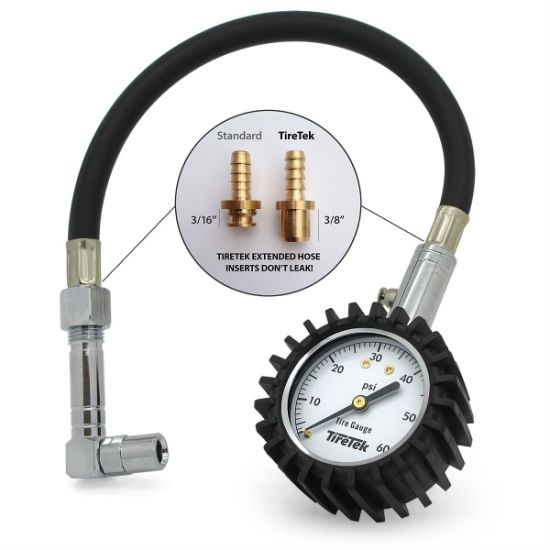 To that end, keeping an eye on tire pressure is a critical part of regular inspection and maintenance. And what’s the tool for that? The humble tire gauge. How accurate is your tire gauge—and how important is it?
To that end, keeping an eye on tire pressure is a critical part of regular inspection and maintenance. And what’s the tool for that? The humble tire gauge. How accurate is your tire gauge—and how important is it?
Tire pressure is a critical function in many different ways. Underinflated (or grossly overinflated) tires don’t handle safely, and if you find yourself in a “steer out of trouble” situation, improperly inflated tires can get you into a lot of trouble. Low tires heat up and can blow out, not only destroying the tire but also putting you in an accident-likely situation.
Keeping tires properly inflated also makes sense from a dollars and sense perspective: Underinflated tires wear out more quickly. Overinflated tires can make the ride rough, and actually wear out suspension parts. And yes, fuel economy is really affected by tire inflation. The popular TV investigation program, “Myth Busters,” found running car tires just five psi (pounds per square inch) low sucks 1. 2 percent more fuel.
2 percent more fuel.
The solution to these safety and money issues is as simple as regularly checking tire inflation. This translates to the diligent use of a simple tire pressure gauge. But sure enough, our human weaknesses sometimes catch up with us. It seems that as more and more of us get the new technology, including tire pressure warning systems, the temptation is to forgo the tire gauge because, “After all, the warning system will let me know if the pressure is low.” Hang on! The typical tire pressure warning system only alerts when pressure drops below 25 percent of the set rate. On a 65-psi truck tire, that translates to 16 psi low. By some measures, you’ll be spending 5 percent more in fuel for that indiscretion.
Tire Gauge Choices
With all this in view, it’s obvious an RVer needs an accurate tire pressure gauge. You’ll find tire gauges just about anywhere that car stuff is sold: auto parts stores, big box retailers, and certainly on the Internet.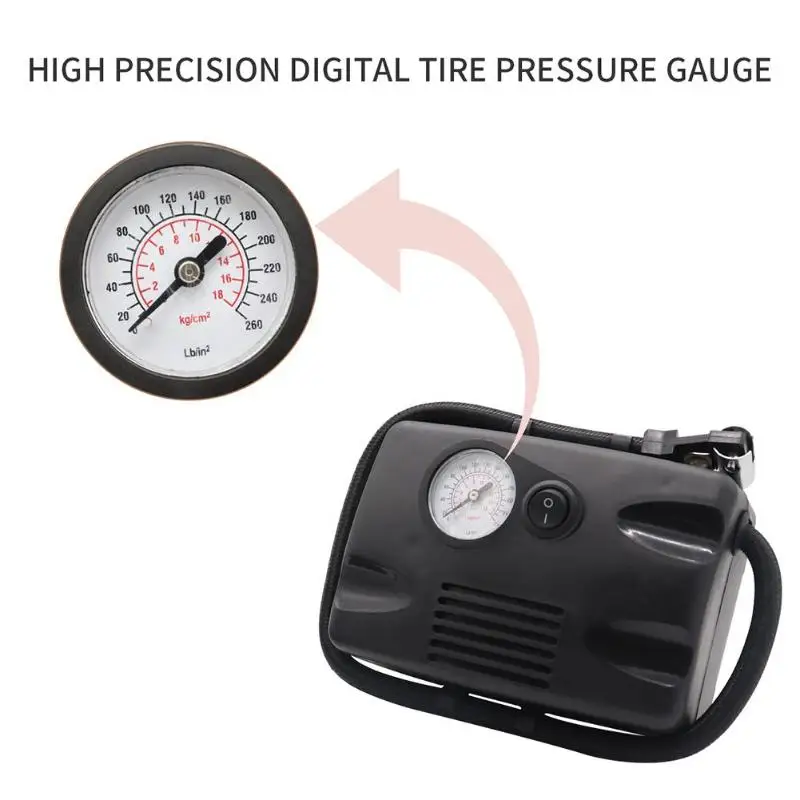 Tire gauges come in three basic types. The “stick” or “pen” type has a plastic or metal indicator that pops up out of the body of the unit. You can pick up a simple stick gauge for as little as a buck. Dial gauges have a “needle on a scale” system; we’ve seen some for sale as low as $5. The latest technology is a digital unit where direct readings are indicated by an electronic display. Prices here start for less than $10 and shoot up to over $100. Still, the bottom line question is, how can you be sure you’ll get an accurate gauge?
Tire gauges come in three basic types. The “stick” or “pen” type has a plastic or metal indicator that pops up out of the body of the unit. You can pick up a simple stick gauge for as little as a buck. Dial gauges have a “needle on a scale” system; we’ve seen some for sale as low as $5. The latest technology is a digital unit where direct readings are indicated by an electronic display. Prices here start for less than $10 and shoot up to over $100. Still, the bottom line question is, how can you be sure you’ll get an accurate gauge?
One RVer with access to a calibrated air pressure “standard” tested nearly 40 tire gauges of various types. Brand new and used units made up those he tested, and some things became immediately clear: Don’t count on the accuracy of cheap stick-style gauges. Five brand-new stick gauges, fresh off the shelf, were tested, and each one gave a different reading. Larger stick-type gauges, as might be used by folks with dual tires (needing a “double head”), were better in accuracy then the shirt-pocket-sized gauges, even so they rarely met an accurate mark.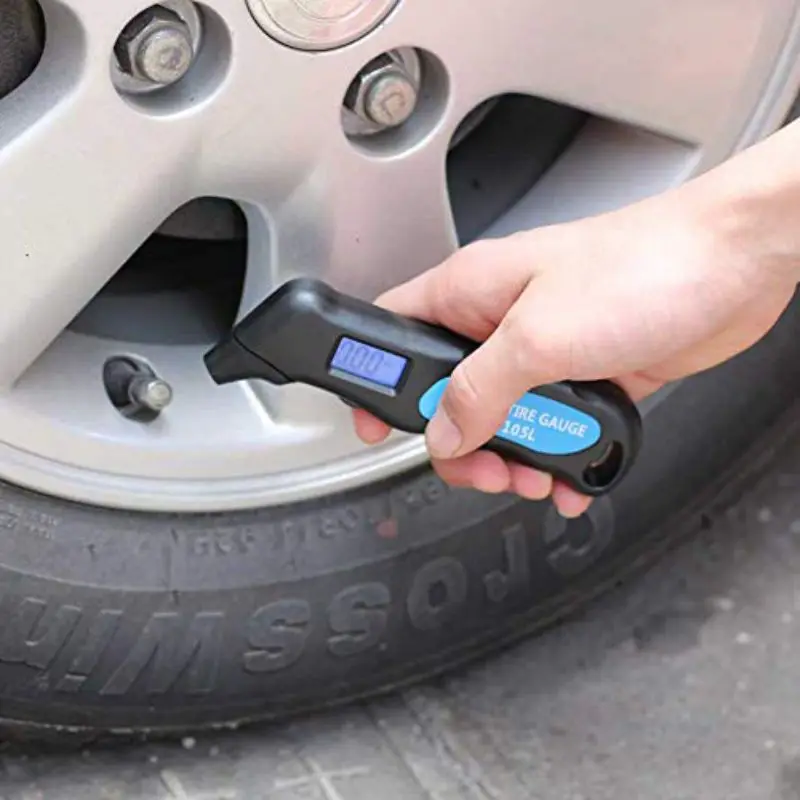 Exercising these gauges by pulling the indicators in and out, or lubricating them, did little to help accuracy.
Exercising these gauges by pulling the indicators in and out, or lubricating them, did little to help accuracy.
Dial gauges tended to come closer to a standard for accuracy, but even there, be careful with their use. A dropped gauge can easily lose accuracy, leaving you holding the bag. If you drop your dial gauge, it may be best to replace it.
Top Models
What about digital gauges? Consumer Reports magazine recently published the results of tests it made on 14 tire gauges. Of the top three rated gauges, two were digital, one a dial. All three got excellent marks for accuracy and durability, and scored “very good” in terms of ease of use. The top two digital models were made by Accutire, models MS-4400B and MS-4021B. Both of these gauges retail for less than $12 each. The third-ranked Intercomp model 360060 was a dial model, and retailed for over $50. So in the world of tire gauges, “you get what you pay for” may not apply. Mind you, just because a tire gauge is a digital device doesn’t mean accuracy is assured. Three digital units tested were marked as only “good” or “fair,” while one stick model got a “very good” rating for accuracy.
Mind you, just because a tire gauge is a digital device doesn’t mean accuracy is assured. Three digital units tested were marked as only “good” or “fair,” while one stick model got a “very good” rating for accuracy.
Whichever gauge you buy, treat it carefully. Dropping any gauge can result in accuracy issues. Digital models operate on batteries, and batteries, with time and use, do tend to wear out. A weak battery could result in inaccurate readings, so keep an eye on them.
Finally, check and inflate your tires with accuracy. Test tires when “cold,” before you pull out. If you can’t fill the tire without moving the rig, then write down how low each tire is. When you get to the filling location, recheck the tire pressure, then add however many pounds you were low to the reading you get at the station. Just traveling a couple of miles can heat up the tire (and the air inside) enough to make a big difference.
Russ and Tiña De Maris are authors of RV Boondocking Basics—A Guide to Living Without Hookups, which covers a full range of dry camping topics, and Camp Hosting USA—Your Guide to State Park Volunteering. Visit icanrv.com for more information.
Visit icanrv.com for more information.
01/05/2022 10 290 1 3 Dashboard
Author: Ivan Baranov
A pressure gauge is a device whose purpose is to measure the pressure level. And the need to measure the pressure of a motorist may arise in different cases. You can find out more about how automobile pressure gauges are calibrated at home, and what requirements apply to these devices, below.
Content
[Expand]
[Hide]
First, consider the requirements for pressure gauges in accordance with GOST:
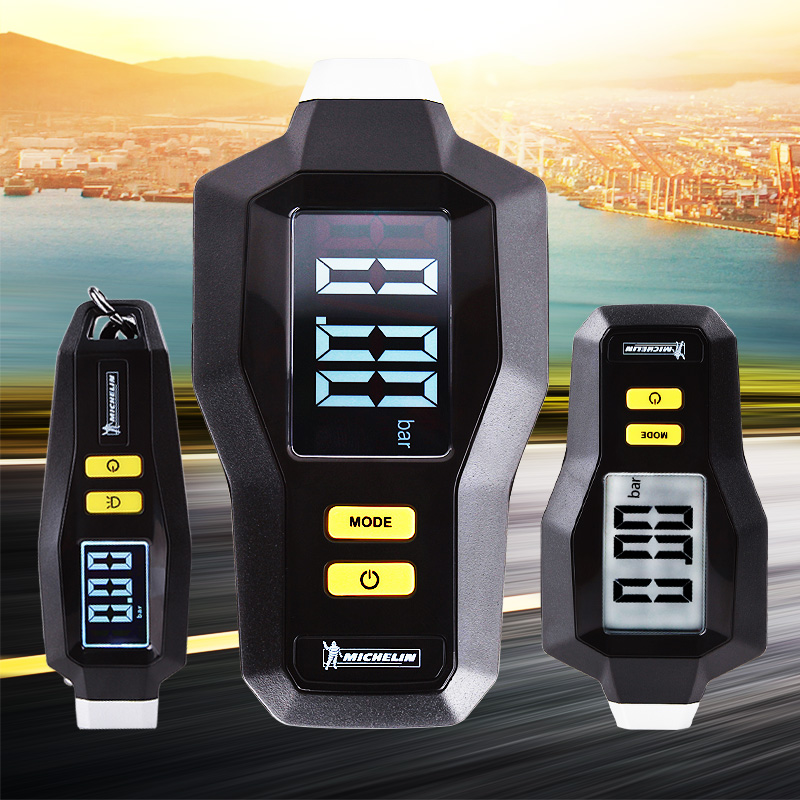
These are the basic requirements for devices of this type in accordance with GOST.
Daewoo compressor pressure sensorNext, we suggest you learn about the calibration of the device.
The device calibration procedure itself can generally be divided into several basic steps:

As for the actual calibration, this procedure includes many checks and adjustments. In the event that the device is fully calibrated, this will mean that with its help it will be possible to obtain the most accurate values of the parameters that you measure.
Now let's talk briefly about the equipment that may be needed for calibration. The main equipment that will be required should include a so-called reference instrument, a source of operating pressure that can be adjusted as needed. You will also need elements for connecting the device to a pressure source and a reference device, and several tools that will be useful for adjusting the device. The purpose of measuring devices is to transfer the dimensions of physical units from standards to working devices.
Photo 1. AM for measuring pressure Photo 2. Tire pressure measurement As for the measuring tools (measuring devices), their purpose is to take measurements in industry. According to their accuracy class, they can be divided into technical and laboratory.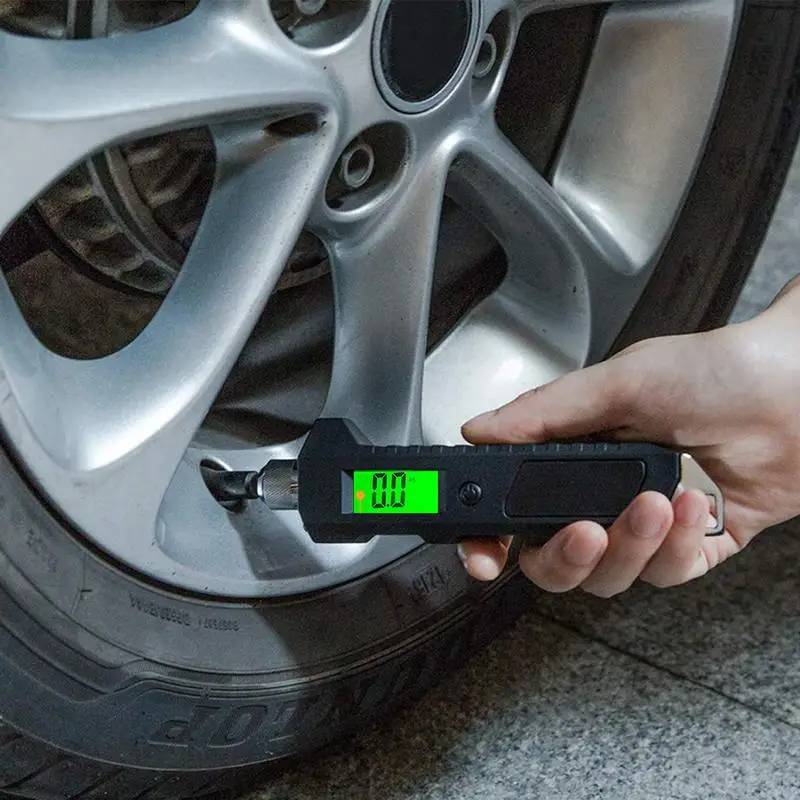 Since not every motorist has such devices, it can be problematic to measure.
Since not every motorist has such devices, it can be problematic to measure.
Now let's talk about how pressure gauges are checked, what terms and frequency of checked devices and what rules should be observed.
If the calibration of pressure gauges is carried out in laboratory conditions, then according to the rules it includes the following steps:
As for the frequency, in enterprises it is usually entered in the appropriate audit log. But since ordinary motorists usually do not start a log of control checks of pressure gauges, this information can be recorded separately in a notebook. The frequency of diagnostics may vary depending on the manufacturer of the device, according to the rules, on average, it can be from 12 to 60 months (the author of the video is the Avtozvuk. ua channel - Autosound Base).
ua channel - Autosound Base).
Now, briefly about how to check the pressure gauge on your own. Before proceeding with the measurement, it is necessary to make a visual diagnosis of the device. Carefully inspect the case for cracks, chips, gaps, or other mechanical damage that could cause the device to malfunction. If you notice traces of damage, while the device does not work in principle, then its further diagnostics will most likely be useless. It will be much easier to buy a new device than to spend time and resources on repairing an old one.
As for directly diagnosing the values, it is carried out as follows:
 If you measure compression in the cylinders of a power unit or, for example, in car tires, then measure the pressure first with one device, and then with another. In the event that the readings of your device do not match the reference, you need to adjust it. You need to ensure that the readings from the measurement using the two devices match.
If you measure compression in the cylinders of a power unit or, for example, in car tires, then measure the pressure first with one device, and then with another. In the event that the readings of your device do not match the reference, you need to adjust it. You need to ensure that the readings from the measurement using the two devices match. 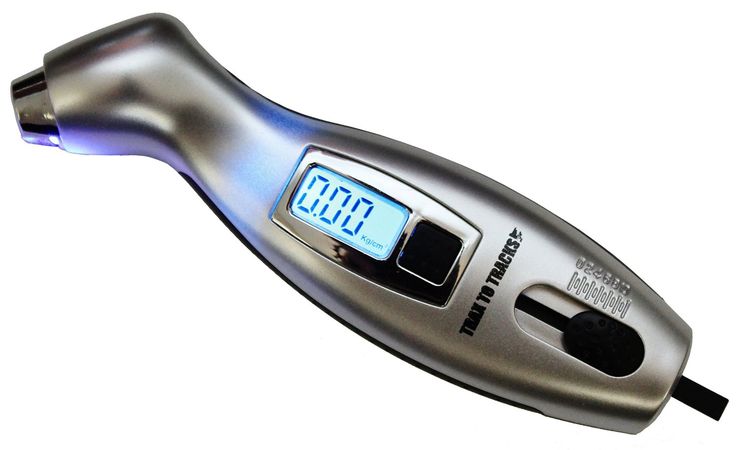 The vessel should be tightly closed and slightly heated to increase the temperature and pressure, which should also be measured. You should calculate the pressure reading in the vessel itself by dividing the final heating temperature with the initial, room temperature. After that, the result should be multiplied by the atmospheric pressure.
The vessel should be tightly closed and slightly heated to increase the temperature and pressure, which should also be measured. You should calculate the pressure reading in the vessel itself by dividing the final heating temperature with the initial, room temperature. After that, the result should be multiplied by the atmospheric pressure. 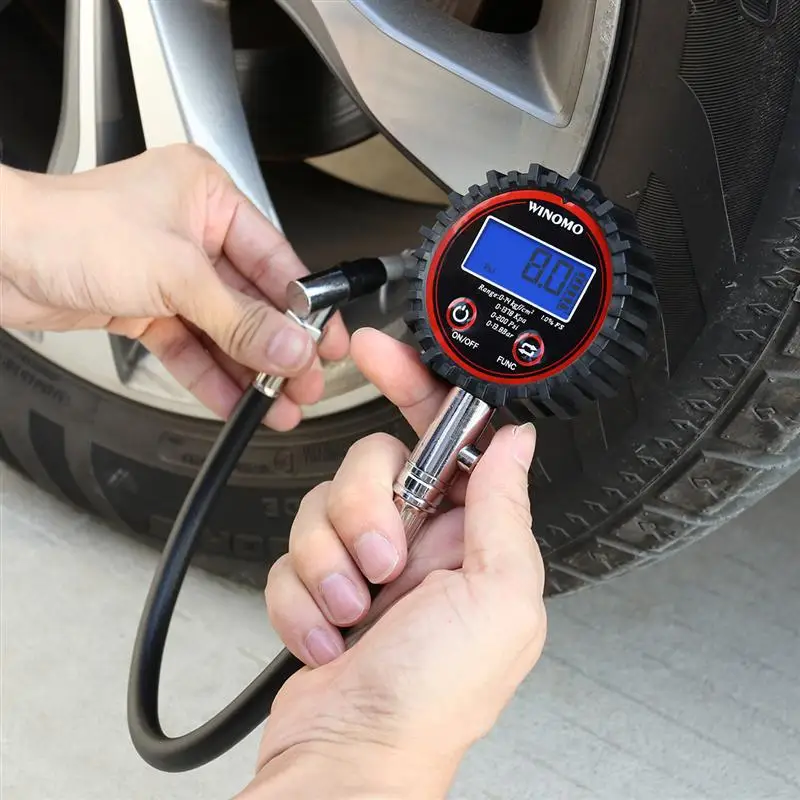
If the adjustment does not give the desired results and the readings obtained from the device are not correct, you can try to give the device for diagnostics to specialists. But if in the laboratory it was not possible to obtain the desired result, then the only way out is to repair the device or replace it.
Loading ...
In the video below you can see an overview of a digital automobile device brought from China (the author of the review is Andrey Kanaev).
Was this article helpful?
Thank you for your opinion!
This article was helpful Please share this information with your friends
Yes (37.50%)
No (62.50%)
March 15, 2019 Equipment and malfunctions km electric
One of the most important parts in car maintenance is tire pressure measurement.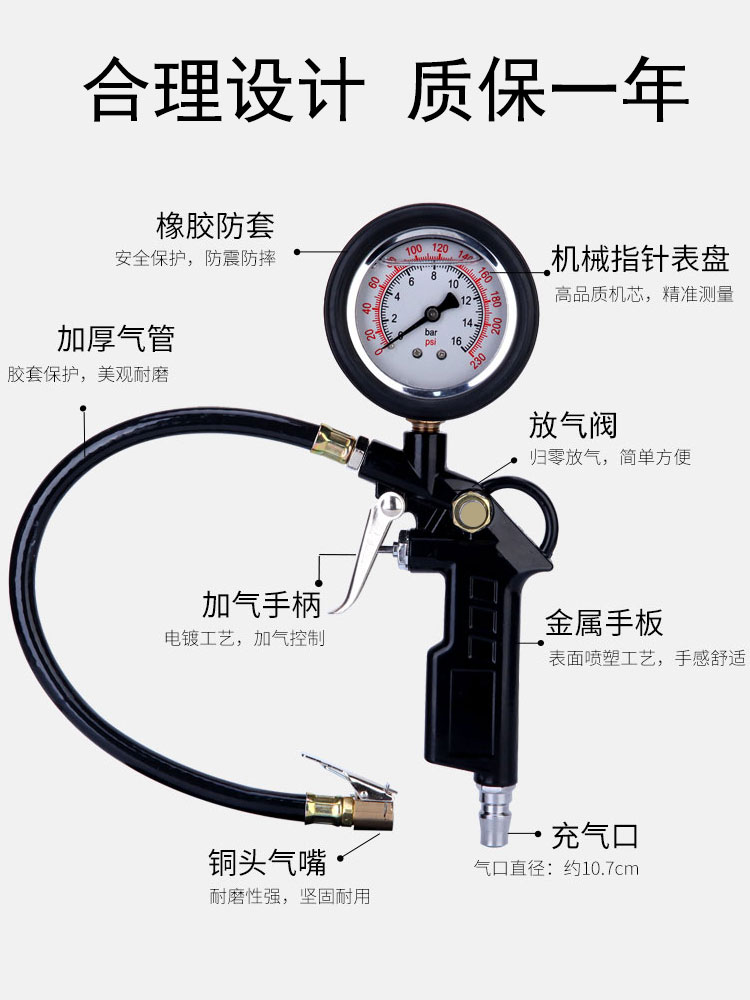 It is very important that the pressure is measured correctly and complies with the standards, because in many respects the safety of the vehicle depends on it. To measure the pressure value, a special device is used, which is called a manometer. In addition to the use of a pressure gauge in car maintenance, there are other areas where one cannot do without it. This device is used in various enterprises in the production process.
It is very important that the pressure is measured correctly and complies with the standards, because in many respects the safety of the vehicle depends on it. To measure the pressure value, a special device is used, which is called a manometer. In addition to the use of a pressure gauge in car maintenance, there are other areas where one cannot do without it. This device is used in various enterprises in the production process.
You can measure tire pressure yourself if you have this device, or you can contact a service station. It does not matter where and how the pressure is measured, it is important that the device is corrected and shows the exact value. Exit check of pressure gauges is carried out in special laboratories.
There are specialized companies that provide a service for checking pressure gauges for accuracy.
Measured with a manometer:
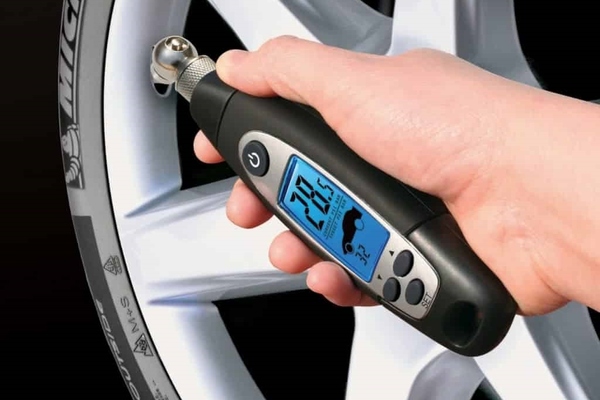
In the event that the device does not work correctly, it is imperative to check it. The purpose of checking the pressure gauge is to detect an error and correct it.
Field inspection and calibration of the pressure gauge is carried out exclusively by qualified specialists who are specially trained. Testing takes place on specialized equipment, which is located in the laboratory.
One of the types of equipment used to check and calibrate the pressure gauge is the MP 60 deadweight tester, which makes it possible to perform an accurate and qualified test.
When testing the accuracy of a pressure gauge in a laboratory, certain rules must be observed:
See also:
Installation and configuration of video surveillance systems http://euroelectrica.
